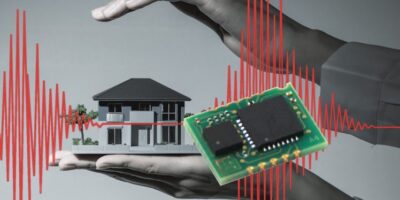Detection sensor distinguishes earthquake from false alarms
False detection prevention is a built-in function of the BP3901 compact, high accuracy, seismic detection sensor module, from Rohm Semiconductor. The BP3901 can be used for applications requiring reliable earthquake detection, such as automatic doors, unmanned transport vehicles, and smart meters.
Accurately detecting vibration when an earthquake occurs and for stopping operation of equipment prevents secondary disasters following an earthquake and are also used to detect damage conditions and assist with early recovery. Rohm points out that mechanical earthquake detectors can only detect the presence/absence of vibration and cannot distinguish whether the vibration is due to an actual earthquake or to other external factors, which often results in false positives.
The compact BP3901 measures 11.8 x 8.6 x 2.5mm and integrates an original earthquake detection algorithm and a false detection prevention function to make it capable of accurately distinguishing between vibration due to earthquakes or other external factors. It also has an angle correction function (±15 degrees allowable mounting angle) to correct for unintentional tilt of the module.
The BP3901 incorporates a three-axis accelerometer. The earthquake detection algorithm focuses on determining spectrum intensity (SI) values. The algorithm has a high correlation with measured seismic intensity data used for earthquake damage assessment while it also optimises the digital signal processing of acceleration data and calculation parameters/sequence through analysis of measured excitation data. This makes it possible, says Rohm, to accurately measure the seismic level, enabling more precise earthquake detection compared with conventional mechanical sensors.
By conducting detailed analysis of vibration waveforms and integrating a false detection prevention function, Rohm was able to distinguish between waveforms due to external factors’ vibrations and actual seismic events.
Conventional earthquake detectors can encounter problems in detecting earthquakes due to deviations in the internal seismic detection function and inclination that occurs over time. The BP3901 achieves angle correction by combining the characteristics of the built-in accelerometer with new angle compensation operation. This allows it to correct for inclination within the vertical planes by up to ±15 degrees (three times that of conventional products) in response to the gravitational acceleration of the Earth.
The module is designed to stay in standby mode until a seismic event is detected to prolong application operation. Standby current consumption is 3.5 microA, achieved by optimising arithmetic processing, explains Rohm. For example, installing this module in a fan heater exposed to an average of 10 seismic events a month, each with a duration of 180 seconds each time, enables operation for up to five years or more, using just two alkaline AA batteries (in series).
The BP3901 saves calculated seismic data in non-volatile memory when the vibration exceeds a certain level. The last 16 seismic events can be stored in order of earthquake magnitude. Analysing earthquake data collected at various locations will make it possible to predict future earthquakes. Comparison of past earthquake data with damage conditions and equipment deterioration it is also expected to see use in earthquake recovery work and maintenance prioritization.
The BP3901 is sampling now, with OEM quantities in August.
Rohm has said that it will continue to develop algorithms optimised for different vibration detection and expand its sensor module offering.




